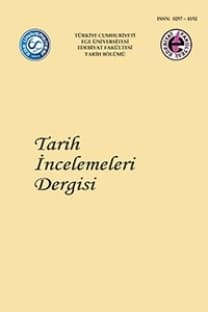PRAISING THE TURK AFTER NICOPOLIS: FRENCH SOURCES
The Crusade of Nicopolis (1396) fought and led by a great number of Franco Burgundian noblemen and knights against the Ottoman Turks was a great blow to Christendom and especially to the kingdom of France. The impact of the defeat in France can easily be detected from contemporary writings where, in addition to lamenting the defeat, there was a critical stance towards the crusaders coupled with an apparent awe towards Ottoman soldiers. The presence of similar themes in different genres of writing in the period may suggest an early humanist tendency that enables an objective evaluation of the infidel albeit hand in hand with the commonplace “scourge of God” theme. Moreover, however they should possibly be based on true accounts, the authors’ praise of Turks may have served a completely different agenda given the background of the contemporary decadence among men-at-arms in France, going through a difficult time in terms of its military and politics.
___
- Abay 2009 Eşref Abay, “Dibekdüzü. Van/Ayanis Kalesi Yakınında Bir Höyük Yerleşimi”. Altan Çilingiroğlu'na Armağan. Yukarı Denizin Kıyısında Urartu Krallığı'na Adanmış Bir Hayat/ Studies in Honour of Altan Çilingiroğlu A Life Dedicated to Urartu on the Shores of the Upper Sea. (eds.) H. Sağlamtimur et al. İstanbul, Arkeoloji ve Sanat Yayınları: pp. 67-85
- Barnett 1982 R. D. Barnett, “Urartu”. The Cambridge Ancient History, Volume 3/1: The Prehistory of the Balkans, the Middle East and the Aegean World, Tenth to Eighth Centuries BC. (eds.) J. Boardman, I. E. S. Edwards, N. G. L. Hammond and E. Sollberger. Cambridge University Press: pp. 314-371.
- Belli 1977 O. Belli, Urartu Bölgesi Yol Şebekesi. PhD dissertation, İstanbul Üniversitesi, Sosyal Bilimler Enstitüsü, İstanbul.
- Belli 2000 O. Belli, “Doğu Anadolu’da Urartu Yol Şebekesinin Araştırılması”. Türkiye Arkeolojisi ve İstanbul Üniversitesi (1932-1999). (ed.) O. Belli. Ankara, İstanbul Üniversitesi: pp. 409-414.
- Belli 2004 O. Belli, “An Early Iron Age and Urartian Fortress in The Van Region: Aliler”, Studi Micenei ed Egeo-Anatolici 46-1, pp. 5-14.
- Belli and Konyar 2003 O. Belli and E. Konyar, Doğu Anadolu Bölgesi’nde Erken Demir Çağ Kale ve Nekropolleri, İstanbul, Arkeoloji ve Sanat Yayınları. Burney 1957 C. A. Burney, “Urartian Fortresses and Towns in Van Region”, Anatolian Studies 7, pp. 37-53.
- CTU I M. Salvini, Corpus Dei Testi Urartei, Vol. I-III, (CTU I-III), Istituto di Studi Civilta Dell’e Egeo Del Vicino Oriente, Documenta Asiana, 2008, Roma
- CTU IV M. Salvini, Corpus Dei Testi Urartei, Vol. IV: Iscrizioni Su Bronzi, Argilla E Altri Supporti Nuove Iscrizioni, Editions De Boccard, 2016.
- Çiftçi and et alii. 2008 Y. Çiftçi, M. A. Işık, T. Alkevli and Ç. Yeşilova, “Van Gölü Havzasının Çevre Jeolojisi / Environmental Geology of Lake Van Basin”, Jeoloji Mühendisliği Dergisi 32/2, pp. 45-77
- Dan 2018 R. Dan, “Some Reflections on ‘Urartian Roads and Urartian Road System/Urartu Yol Sistemi ve ‘Urartu’ Yolları Üzerine Bazı Düşünceler”. Eski Yakındoğu’da Ulaşım Üzerine Yazılar/Articles on Transportation in Ancient Near East. (eds.) B. Gökce and P. Pınarcık. İstanbul, Akademisyen Yayınevi: pp. 355-367.
- Derin and Sağlamtimur 1998 Z. Derin and A. H. Sağlamtimur, “Alaköy Kalesi ve Kalede Bulunan Urartu Heykelleri”, Belleten LXII/233, pp. 15-23.
- Işık 2017 K. Işık, Urartu Yazılı Kaynaklarında Geçen Yer Adları ve Lokalizasyonları. PhD dissertation, Van Yüzüncü Yıl Universitesi Sosyal Bilimler Enstitüsü Protohistorya ve Önasya Arkeolojisi Anabilim Dalı.
- Korfmann 1977 M. Korfmann, “Die Ausgrabungen von Kirsopp und Silva Lake in den Jahren 1938 und 1939 am Burgfelsen von Van (Tušpa) und in Kalecik”, Berytus XXV, pp. 173-200.
- Özfırat 2007 A. Özfırat, “Van, Ağrı, Iğdır İlleri Yüzey Araştırması, 2005”, Araştırma Sonuçları Toplantısı 24/1, pp. 143-162.
- Özfırat 2012 A. Özfırat, “Van, Ağrı ve Iğdır İlleri Yüzey Araştırması, 2010”, 29. Araştırma Sonuçları Toplantısı, pp. 155-173.
- Özfırat 2015 A. Özfırat, “Van Gölü Havzasında Yeni Araştırmalar”, XVI. Türk Tarih Kongresi I, pp. 1-17.
- Salvini 2001 M. Salvini, “Inscription on Clay”. Ayanis I. Ten Years of Excavations at Rusahinili Eiduru-kai 1989-1998. (eds.) A. Çilingiroğlu and M. Salvini. Roma, pp. 279-319.
- Saraçoğlu 1989 H. Saraçoğlu, Doğu Anadolu Bölgesi, MEB Öğretmen Kitapları Dizisi, İstanbul.
- Sayce 1882 A.H. Sayce, "The Cuneiform Inscriptions of Van, Deciphered and Translated", The Journal of the Royal Asiatic Society of Great Britain and Ireland 14/4, pp. 377-732.
- Sevin 1989 V. Sevin, “Urartular’a Ait Dünyanın En Eski Karayolu”, Anadolu Araştırmaları XI, pp. 47-56.
- Sevin 2005 V. Sevin, “Son Tunç/Erken Demir Çağı Van Bölgesi Kronolojisi. Kökeni Aranan Bir Devlet: Urartu”, Belleten 252, pp. 355-400.
- Sevin 2006 V. Sevin, “Keçikıran: Van Bölgesinden Yarım Kalmış Bir Urartu Projesi”. Hayat Erkanal’a Armağan. Kültürlerin Yansıması/ Studies in Honor of Hayat Erkanal. Cultural Reflections. (eds.) A. Öktü, E. Özgen et al., İstanbul, Homer Kitabevi: pp. 667-674.
- Zimansky 1985 P. E. Zimansky, Ecology and Empire: The Structure of the Urartian State, Chicago
- Zimansky 2005 P. E. Zimansky, “The cities of Rusa II and the end of Urartu”. Anatolian Iron Ages 5: Proceedings of the Fifth Anatolian Iron Ages Colloquium held at Van, 6-10 August 2001. (eds.) A. Çilingiroğlu and G. Darbyshire. London, British Institute at Ankara: pp. 235-240.
- ISSN: 0257-4152
- Başlangıç: 1983
- Yayıncı: Prof. Dr. Süleyman Özkan
Sayıdaki Diğer Makaleler
DEMOKRAT PARTİ’NİN İLK KADIN MİLLETVEKİLİ: HATİCE NAZLI TLABAR (1913-1971)
Teğmen Herbert Chermsıde’ın Raporlarında Keldaniler, Nasturiler, Yezidiler ve Kürtler (1881-1882)
Nokta ve Ünlem Savaşı: Yeni Gerçeklik ve Karabağ: Karabağ’a Düşen Cemre
PRAISING THE TURK AFTER NICOPOLIS: FRENCH SOURCES
Sultan Melikşah’ın Eşlerinden Çağrı Bey’in Torunu Zübeyde Hâtun
Bilcan GÖKÇE, Rıfat KUVANÇ, Bülent GENÇ
Ortaçağ Müslüman Devletlerinde Hayvanat Bahçeleri
Osmanlı İmparatorluğu’nda Diplomatik Dokunulmazlık ve Şifreli Diplomatik Haberleşme
Tonkin (Vietnam)’daki Le-Trinh Döneminde Diarşi Sistemi Üzerine Bir İnceleme (17.-18. Asırlarda)
